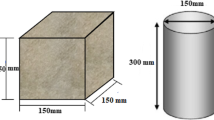Abstract
In order to reduce the dead load of the structures prone to seismic hazards and improve the insulating characteristics of construction materials with the purpose of economical construction, lightweight aggregate (LWA) concrete (LWAC) could be pondered. In this paper, the effect of different parameters such as volume fraction, LWA grading and sand to cement ratio on compressive strength, and elastic modulus of lightweight concrete have been studied. In this study, 36 different mix designs were developed; 3 different sand to cement ratios, 4 volume fractions and 3 different gradings of LWA were considered in order to study the effect of these parameters and find out an efficient mix design for structural use. In order to investigate the effect of each parameter on the compressive strength and elastic modulus, a multivariate analysis of variation was performed. Results indicate that the volume fraction and the LWA grading are the two key parameters influencing compressive strength comparing with sand to cement ratios. Moreover, it was concluded that the sand to cement (S/C) ratio could be as effective as other parameters on elastic modulus of LWAC.
















Similar content being viewed by others
References
ACI Committee 213 (2003) Guide for structural lightweight aggregate concrete. American Concrete Institute
Canadian Standards Association (2004) Design of concrete structures. Canadian Standards Association; A23.3-04
Yang CC, Huang R (1998) Approximate strength of lightweight aggregate using micromechanics method. Adv Cem Based Mater 7:133–138
Ke Y, Beaucour AL, Ortola S, Dumontet H, Cabrillaca R (2009) Influence of volume fraction and characteristics of lightweight aggregates on the mechanical properties of concrete. Constr Build Mater 23:2821–2828
Chi JM, Huang R, Yang CC, Chang JJ (2003) Effect of aggregate properties on the strength and stiffness of lightweight concrete. Cem Concr Compos 25:197–205
Yang CC, Huang R (1996) A two-phase model for predicting the compressive strength of concrete. Cem Concr Res 26:1567–1577
Zhang MH, Gjorv OE (1990) Characteristics of lightweight aggregates for high-strength concrete. ACI Mater J 88:150–158
Bremner TW, Holm TA (1986) Elastic compatibility and the behavior of concrete. ACI J 83:244–250
Kockal NU, Ozturan T (2011) Strength and elastic properties of structural lightweight concretes. Mater Des 32:2396–2403
Sarkar SL, Chandra S, Berntsson L (1992) Interdependence of microstructure and strength of structural lightweight aggregate concrete. Cem Concr Compos 14:239–248
Grubl P (1979) Mix design of lightweight aggregate concrete for structural purposes. Int J Lightweight Concr 1:63–69
Smadi M, Migdady E (1991) Properties of high strength tuff lightweight aggregate concrete. Cem Concr compos 13:129–135
Nilsen AU, Monteiro PJM, Gjorv OE (1994) Quality assessment of lightweight aggregate. Cem Concr Res 24:1423–1427
Stock AF, Hannant DJ, Williams RIT (1980) The effect of aggregate concentration upon the strength and modulus elasticity of concrete. Mag Concr Res 32:225–234
Lo-shu K, Man-qing S, Xing-sheng S, Yun-xiu L (1980) Research on several physic-mechanical properties of lightweight aggregate concrete. Int J Lightweight Concr 2:185–191
Lazic ZR (2004) Design of experiments in chemical engineering. Wiley, Weinheim
ASTM C150 (2007) Standard specification for Portland cement American Society for Testing Materials
Alengaram UJ, Mahmud H, Jumaat MZ (2011) Enhancement and prediction of modulus of elasticity of palm kernel shell concrete. Mater Des 32:2143–2148
Alengaram UJ, Al Muhit BA, Jumaat MZ (2013) Utilization of oil palm kernel shell as lightweight aggregate in concrete—a review. Constr Build Mater 38:161–172
Nguyen LH, Beaucour A-L, Ortola S, Noumowé A (2014) Influence of the volume fraction and the nature of fine lightweight aggregates on the thermal and mechanical properties of structural concrete. Constr Build Mater 51:121–132
Cui HZ, Yiu Lo T, Memon SA, Xing F, Shi X (2012) Analytical model for compressive strength, elastic modulus and peak strain of structural lightweight aggregate concrete. Constr Build Mater 36:1036–1043
Cui HZ, Yiu Lo T, Memon SA, Xu W (2012) Effect of lightweight aggregates on the mechanical properties and brittleness of lightweight aggregate concrete. Constr Build Mater 35:149–158
Bogas A, Gomes A (2013) Compressive behavior and failure modes of structural lightweight aggregate concrete—characterization and strength prediction. Mater Des 46:832–841
Ismail AIM, Elmaghraby MS, Mekky HS (2013) Engineering properties, microstructure and strength development of lightweight concrete containing pumice aggregates. Geotech Geol Eng 31:1465–1476
Chandra S, Berntsson L (2002) Lightweight aggregate concrete. Noyes Publications/William Andrew Publishing, Norwich. ISBN 0815514867
Ke Y, Ortola S, Beaucour AL, Dumontet H (2010) Identification of microstructural characteristics in lightweight aggregate concretes by micromechanical modelling including the interfacial transition zone (ITZ). Cem Concr Res 40:1590–1600
Ke Y, Ortola S, Beaucour AL, Dumontet H (2014) Micro-stress analysis and identification of lightweight aggregate’s failure strength by micromechanical modeling. Mech Mater 68:176–192
Alexander MG, Milne TI (1995) Influence of cement blend and aggregate type on the stress–strain behavior and elastic modulus of concrete. ACI Mater J 92:227–235
Tommy YL, Tang WC, Cui HZ (2007) The effects of aggregate properties on lightweight concrete. Build Environ 42:3025–3029
Author information
Authors and Affiliations
Corresponding author
Rights and permissions
About this article
Cite this article
Rahai, A., Dolati, A., Kamel, M.E. et al. Studying the effect of various parameters on mechanical properties of lightweight aggregate concrete using MANOVA. Mater Struct 48, 2353–2365 (2015). https://doi.org/10.1617/s11527-014-0317-4
Received:
Accepted:
Published:
Issue Date:
DOI: https://doi.org/10.1617/s11527-014-0317-4




